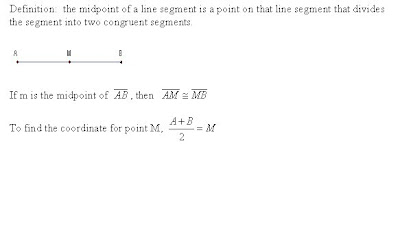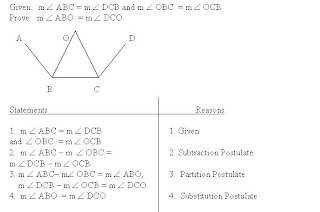4-1 Postulates of lines, line segments, and angles –
Postulates:
4.1 A line segment can be extended to any length in either direction.
4.2 Through two given points, one and only one line can be drawn.
4.3 Two lines cannot intersect in more than one point.
4.4 One and only one circle can be drawn with any given point as it's center and the length of any given line segment as the radius.
4.5 At a given point on a given line, one and only one perpendicular can be drawn to the line.
4.6 From a given point not on a given line, one and only one perpendicular can be drawn to the line.
4.7 For any two distinct points, there is only one positive real number that is the length of the line segment joining the two endpoints.
4.8 The shortest distance between 2 points is the length of the line segment joining these two points.
4.9 A line segment has one and only one midpoint.
5.0 An angle has one and only one bisector.
4.2 Using Postulates and Definitions in Proofs:
We use the laws of logic to combine definitions and postulates to prove a theorem.
We will assume unless otherwise stated, that lines that appear to be straight lines in a figure actually are straight lines and that points that appear on the line actually are.
Example: Given: and AB = CD.
Prove: AC = BD
Statements Reasons
1. AB = CD 1. Given
2. BC = BC 2. Reflexive Postulate
3. AB + BC = CD + BC 3. Addition Postulate
4. AB + BC = AC; CD + BC = BD 4. partition postulate
5. AC = BD 5. Substitution postulate
4.3 Proving Theorems About Angles
Theorem 4.1 If 2 angles are right angles, then they are congruent.
Theorem 4.2 If two angles are straight angles, then they are congruent.
Definitions involving Pairs of Angles:
Definition:
Adjacent Angles are two angles in the same plane that have a common vertex and a common side but do not have any interior points in common.
Definition: Complementary angles are two angles, the sum of whose degree measure is 90 degrees.
Definition: Supplementary angles are two angles, the sum of whose degree measure is 180 degrees.
Theorem 4.3 If two angles are complements of the same angle or congruent angles, then the two angles are congruent.
Theorem 4.4 If two angle are congruent, then their complements are congruent.
Theorem 4.5 If two angles are supplements of the same angle, then they are congruent.
Theorem 4.6 If two angles are congruent, then their supplements are congruent.
If two angles are congruent, then they have the same supplement.
Definition: A linear pair of angles are two adjacent angles whose sum is a straight angle.
Theorem 4.7 If two angles form a linear pair, then they are supplementary.
Theorem 4.8 If two lines intersect to form congruent adjacent angles, then they are perpendicular.
Definition: Vertical angles are two angles in which the sides of one angle are opposite rays to the sides of the second angle.
Theorem 4.9: If two lines intersect, then the vertical angles are congruent.
How to present a proof in geometry using deductive reasoning.
1. As an aid, draw a figure that pictures the data of the theorem or the problem. Use letters to label points in the figure.
2. State the given, which is the hypothesis of the theorem, in terms of the figure.
3. State the Prove, which is the conclusion of the theorem, in terms of the figure.
4. Present the proof, which is a series of logical arguments used in the demonstration. Each step in the proof should consist of a statement about the figure. Each statement should be justified by the given, a definition, a postulate, or a previously proved theorem. The proof may be presented in a two-column format or in a paragraph form.
4.4 Congruent Polygons and Corresponding Parts
Corresponding Parts of Congruent Polygons
Two Polygons are congruent if and only if there is a one-to-one correspondence between their vertices such that corresponding angles are congruent and corresponding sides are congruent.
Therefore: Corresponding parts of congruent polygons are congruent.

Congruent Triangles:
Corresponding parts of congruent triangles are congruent (CPCTC).
if two triangles are congruent, then the corresponding parts are congruent.

Postulates:
Reflexive Postulate: any geometric figure is congruent to itself.
Symmetric Postulate: a congruence may be expressed in either order.
Transitive Postulate: Two geometric figures congruent to the same geometric figure are congruent to each other.
4.5 - 4.7 Proving Triangles Congruent using
5 ways to show Triangle Congruence:
1. SAS = SAS Congruence Postulate - if two sides and the included angle of one triangle are congruent to two sides and the included angle of a second triangle, then the two triangles are congruent.Example: Given ΔABC and ΔDEF,if AB = DE, BC = EF and angle B = angle E, then ΔABC = ΔDEF.
2. SSS = SSS Congruence Postulate - if three sides of one triangle are congruent to three sides of a second triangle, then the two triangles are congruent.Example: Given ΔABC and ΔDEF,if AB = DE, BC = EF and AC = DF, then ΔABC = ΔDEF.
3. ASA = ASA Congruence Postulate - if two angles and the included side of one triangle are congruent to two angles and the included side of a second triangle, then the two triangles are congruent.Example: Given ΔABC and ΔDEF,if angle A = angle D, AB = DE, and angle B = angle E, then Δ ABC = Δ DEF.
4. AAS = AAS Congruence Postulate - if two angles and a non-included side of one triangle are congruent to two angles and the corresponding non-included side of a second triangle, then the two triangles are congruent.Example: Given Δ ABC and Δ DEF,if angle A = angle D, angle C = angle F, and BC = EF , then Δ ABC = Δ DEF.
5. HL = HL Congruence Postulate - if the leg and hypotenuse of one right triangle is congruent to the corresponding leg and hypotenuse of another right triangle, then the two triangles are congruent by hypotenuse - leg postulate.Example: Given right Δ ABC and right Δ DEF, if angle B and angle E are both right angles and leg AB = leg DE and hypotenuse AC = hypotenuse DF, then Δ ABC = Δ DEF.










































